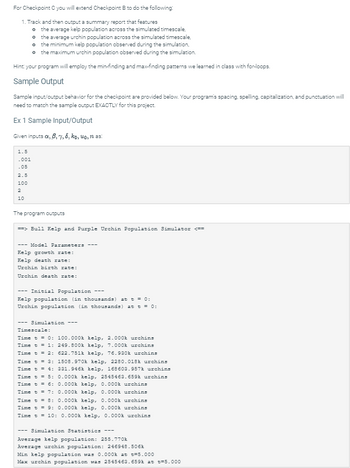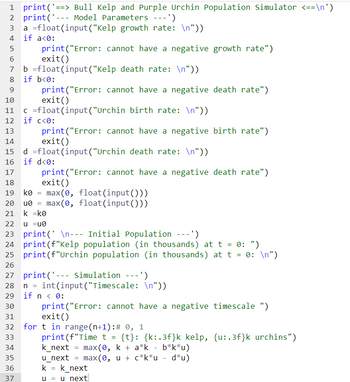For Checkpoint C you will extend Checkpoint B to do the following: 1. Track and then output a summary report that features 0 the average kelp population across the simulated timescale, o the average urchin population across the simulated timescale, o the minimum kelp population observed during the simulation, o the maximum urchin population observed during the simulation. Hint: your program will employ the min-finding and max-finding patterns we learned in class with for-loops. Sample Output Sample input/output behavior for the checkpoint are provided below. Your program's spacing, spelling, capitalization, and punctuation will need to match the sample output EXACTLY for this project. Ex 1 Sample Input/Output Given inputs xx, 6, 7, 8, ko, uo, n as: 1.5 -001 .05 2.5 100 2 10 The program outputs ==> Bull Kelp and Purple Urchin Population Simulator <== ---Model Parameters Kelp growth rate: Kelp death rate: Urchin birth rate: Urchin death rate: Initial Population Kelp population (in thousands) at t = 0: Urchin population (in thousands) at t = 0: --- Simulation --- Timescale: Time t = 0: 100.000k kelp, 2.000k urchins Time t = 1: 249.800k kelp, 7.000k urchins Time t = 2: 622.751k kelp, 76.930k urchins Time t = 3: Time t = 4: Time t = 5: Time t = 6: Time t = 7: 1508.970k kelp, 2280.018k urchins 331.946k kelp, 168603.957k urchins 0.000k kelp, 2545463.659k urchins 0.000k kelp, 0.000k urchins 0.000k kelp, 0.000k urchins Time t = 8: 0.000k kelp, 0.000k urchins Time t = 9: 0.000k kelp, 0.000k urchins Time t = 10: 0.000k kelp, 0.000k urchins --- Simulation Statistics --- Average kelp population: 255.770k Average urchin population: 246948.506k Min kelp population was 0.000k at t=5.000 Max urchin population was 2545463.659k at t=5.000 1 print('==> Bull Kelp and Purple Urchin Population Simulator <==\n') 2 print('- Model Parameters ---') a float(input ("Kelp growth rate: \n")) if a<0: print("Error: cannot have a negative growth rate") exit() b =float(input("Kelp death rate: \n")) 8 if b<0: 9 10 11 c =float 12 if c<0: 13 14 4 5 6 16 17 18 19 ko 29 30 31 print("Error: cannot have a negative death rate") exit() ko = max(0, float(input())) 20 u0= max(0, float(input())) 21 k =k0 33 34 35 22 u =u0 23 print( \n--- Initial Population ---') 24 print (f"Kelp population (in thousands) at t = 0: ") 25 print (f"Urchin population (in thousands) at t = 0: \n") 26 27 print('--- Simulation ---') m m m print("Error: exit() 36 (input("Urchin birth rate: \n")) print("Error: cannot have a negative birth rate") exit() d =float (input ("Urchin death rate: \n")) if d<0: 37 cannot have a negative death rate") n = int(input("Timescale: \n")) if n < 0: print("Error: cannot have a negative timescale ") exit() for t in range (n+1): # 0, 1 print (f"Time t = {t}: {k:.3f}k kelp, {u:.3f}k urchins") k_next = max(0, k + a*k - b*k*u) u_next max (0, u + c*k*u - d*u) k = k_next u = u next
For Checkpoint C you will extend Checkpoint B to do the following: 1. Track and then output a summary report that features 0 the average kelp population across the simulated timescale, o the average urchin population across the simulated timescale, o the minimum kelp population observed during the simulation, o the maximum urchin population observed during the simulation. Hint: your program will employ the min-finding and max-finding patterns we learned in class with for-loops. Sample Output Sample input/output behavior for the checkpoint are provided below. Your program's spacing, spelling, capitalization, and punctuation will need to match the sample output EXACTLY for this project. Ex 1 Sample Input/Output Given inputs xx, 6, 7, 8, ko, uo, n as: 1.5 -001 .05 2.5 100 2 10 The program outputs ==> Bull Kelp and Purple Urchin Population Simulator <== ---Model Parameters Kelp growth rate: Kelp death rate: Urchin birth rate: Urchin death rate: Initial Population Kelp population (in thousands) at t = 0: Urchin population (in thousands) at t = 0: --- Simulation --- Timescale: Time t = 0: 100.000k kelp, 2.000k urchins Time t = 1: 249.800k kelp, 7.000k urchins Time t = 2: 622.751k kelp, 76.930k urchins Time t = 3: Time t = 4: Time t = 5: Time t = 6: Time t = 7: 1508.970k kelp, 2280.018k urchins 331.946k kelp, 168603.957k urchins 0.000k kelp, 2545463.659k urchins 0.000k kelp, 0.000k urchins 0.000k kelp, 0.000k urchins Time t = 8: 0.000k kelp, 0.000k urchins Time t = 9: 0.000k kelp, 0.000k urchins Time t = 10: 0.000k kelp, 0.000k urchins --- Simulation Statistics --- Average kelp population: 255.770k Average urchin population: 246948.506k Min kelp population was 0.000k at t=5.000 Max urchin population was 2545463.659k at t=5.000 1 print('==> Bull Kelp and Purple Urchin Population Simulator <==\n') 2 print('- Model Parameters ---') a float(input ("Kelp growth rate: \n")) if a<0: print("Error: cannot have a negative growth rate") exit() b =float(input("Kelp death rate: \n")) 8 if b<0: 9 10 11 c =float 12 if c<0: 13 14 4 5 6 16 17 18 19 ko 29 30 31 print("Error: cannot have a negative death rate") exit() ko = max(0, float(input())) 20 u0= max(0, float(input())) 21 k =k0 33 34 35 22 u =u0 23 print( \n--- Initial Population ---') 24 print (f"Kelp population (in thousands) at t = 0: ") 25 print (f"Urchin population (in thousands) at t = 0: \n") 26 27 print('--- Simulation ---') m m m print("Error: exit() 36 (input("Urchin birth rate: \n")) print("Error: cannot have a negative birth rate") exit() d =float (input ("Urchin death rate: \n")) if d<0: 37 cannot have a negative death rate") n = int(input("Timescale: \n")) if n < 0: print("Error: cannot have a negative timescale ") exit() for t in range (n+1): # 0, 1 print (f"Time t = {t}: {k:.3f}k kelp, {u:.3f}k urchins") k_next = max(0, k + a*k - b*k*u) u_next max (0, u + c*k*u - d*u) k = k_next u = u next
Oh no! Our experts couldn't answer your question.
Don't worry! We won't leave you hanging. Plus, we're giving you back one question for the inconvenience.
Submit your question and receive a step-by-step explanation from our experts in as fast as 30 minutes.
You have no more questions left.
Message from our expert:
Our experts need more information to provide you with a solution. Checkpoint B is missing. Please resubmit your question, making sure it's detailed and complete. We've credited a question to your account.
Your Question:
use python's code when solving this question

Transcribed Image Text:For Checkpoint C you will extend Checkpoint B to do the following:
1. Track and then output a summary report that features
0 the average kelp population across the simulated timescale,
o the average urchin population across the simulated timescale,
o the minimum kelp population observed during the simulation,
o the maximum urchin population observed during the simulation.
Hint: your program will employ the min-finding and max-finding patterns we learned in class with for-loops.
Sample Output
Sample input/output behavior for the checkpoint are provided below. Your program's spacing, spelling, capitalization, and punctuation will
need to match the sample output EXACTLY for this project.
Ex 1 Sample Input/Output
Given inputs xx, 6, 7, 8, ko, uo, n as:
1.5
-001
.05
2.5
100
2
10
The program outputs
==> Bull Kelp and Purple Urchin Population Simulator <==
---Model Parameters
Kelp growth rate:
Kelp death rate:
Urchin birth rate:
Urchin death rate:
Initial Population
Kelp population (in thousands) at t = 0:
Urchin population (in thousands) at t = 0:
--- Simulation ---
Timescale:
Time t = 0: 100.000k kelp, 2.000k urchins
Time t = 1: 249.800k kelp, 7.000k urchins
Time t = 2: 622.751k kelp, 76.930k urchins
Time t = 3:
Time t = 4:
Time t = 5:
Time t = 6:
Time t = 7:
1508.970k kelp, 2280.018k urchins
331.946k kelp, 168603.957k urchins
0.000k kelp, 2545463.659k urchins
0.000k kelp, 0.000k urchins
0.000k kelp, 0.000k urchins
Time t = 8: 0.000k kelp, 0.000k urchins
Time t = 9: 0.000k kelp, 0.000k urchins
Time t = 10: 0.000k kelp, 0.000k urchins
--- Simulation Statistics ---
Average kelp population: 255.770k
Average urchin population: 246948.506k
Min kelp population was 0.000k at t=5.000
Max urchin population was 2545463.659k at t=5.000

Transcribed Image Text:1 print('==> Bull Kelp and Purple Urchin Population Simulator <==\n')
2 print('- Model Parameters ---')
a float(input ("Kelp growth rate: \n"))
if a<0:
print("Error: cannot have a negative growth rate")
exit()
b =float(input("Kelp death rate: \n"))
8 if b<0:
9
10
11 c =float
12 if c<0:
13
14
4
5
6
16
17
18
19 ko
29
30
31
print("Error: cannot have a negative death rate")
exit()
ko = max(0, float(input()))
20 u0= max(0, float(input()))
21
k =k0
33
34
35
22
u =u0
23 print( \n--- Initial Population ---')
24 print (f"Kelp population (in thousands) at t = 0: ")
25 print (f"Urchin population (in thousands) at t = 0: \n")
26
27 print('--- Simulation ---')
m m m
print("Error:
exit()
36
(input("Urchin birth rate: \n"))
print("Error: cannot have a negative birth rate")
exit()
d =float (input ("Urchin death rate: \n"))
if d<0:
37
cannot have a negative death rate")
n = int(input("Timescale: \n"))
if n < 0:
print("Error: cannot have a negative timescale ")
exit()
for t in range (n+1): # 0, 1
print (f"Time t = {t}: {k:.3f}k kelp, {u:.3f}k urchins")
k_next = max(0, k + a*k - b*k*u)
u_next
max (0, u + c*k*u - d*u)
k = k_next
u = u next
Knowledge Booster
Learn more about
Need a deep-dive on the concept behind this application? Look no further. Learn more about this topic, computer-science and related others by exploring similar questions and additional content below.Recommended textbooks for you

C++ Programming: From Problem Analysis to Program…
Computer Science
ISBN:
9781337102087
Author:
D. S. Malik
Publisher:
Cengage Learning

C++ for Engineers and Scientists
Computer Science
ISBN:
9781133187844
Author:
Bronson, Gary J.
Publisher:
Course Technology Ptr

C++ Programming: From Problem Analysis to Program…
Computer Science
ISBN:
9781337102087
Author:
D. S. Malik
Publisher:
Cengage Learning

C++ for Engineers and Scientists
Computer Science
ISBN:
9781133187844
Author:
Bronson, Gary J.
Publisher:
Course Technology Ptr
